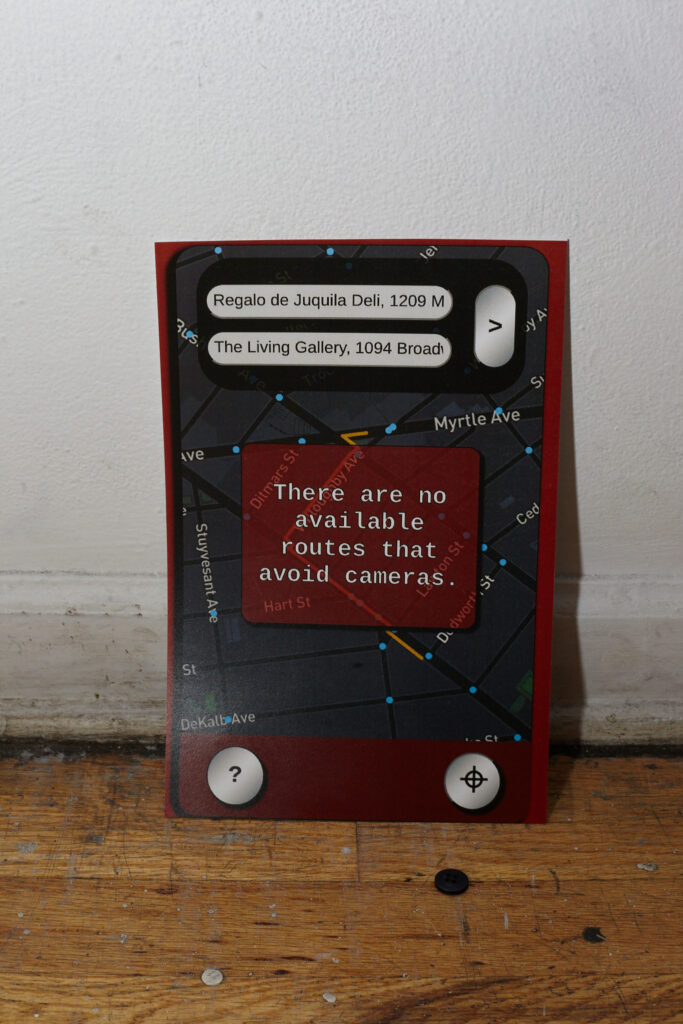discernible.tech
Sam (Sim) Hafferty
Advisor: Luisa Pereira
An interactive web map and field research experience engaging with issues of transparency & consent raised by the expansion of automated policing infrastructure in Brooklyn, New York.

Abstract
discernible.tech is a real-time data exploration tool for mapping routes around public surveillance infrastructure. By inserting a person's live location within a map of surveillance cameras, they are able to more clearly visualize the density & frequency of which they may intersect with the lenses of these cameras. The act of explicitly knowing & sensing these devices which may otherwise remain hidden & forgotten bring to light the issues of transparency & consent that the vast implementation of these cameras in public space raise. Additionally, the ability to map out alternative routes to one's planned ventures that exceed the bounds of this video surveillance (or be faced with the fact that there is no alternate route as often is the case) re-iterates the vastness of these systems and the lack of ability to opt-out of such programs. This project is tied to an ongoing field research experience in which use of the mapping tool is guided by critical conversation and collective reflection.

Technical Details
Built with the Geolocation API, Mapbox (Geocoding API, Navigation API), Amnesty's Decode Surveillance NYC - a crowd-sourced surveillance camera dataset (csv) & plain HTML/CSS/JavaScript. Back-end is served with a secure Node.JS server on a Digital Ocean droplet authenticated with CertBot. R, RStudio & QGIS were used for processing the dataset & creating location markers. User data is never stored and nothing is collected in the background. Field research video documentation captured on handheld camcorder and processed in Premiere Pro. Miscellaneous video editing done with ffmpeg and videogrep.

Research/Context
The presumption of innocence states that "every person accused of any crime is considered innocent until proven guilty", this age-old principle has been enacted into the U.S. judicial system since the landmark 1895 case "Coffin v. United States" and remains the basis for such legal standards as "reasonable doubt" & "probable cause” which grant people in the U.S. protections from unreasonable search & unjust convictions. As just as this all sounds in theory, these ideals are evidently far from being upheld in practice. Growing up in a low-income Latino community & household during the early aughts, the enforcement & surveillance tactics used to act-out war on drugs era legislation were all too familiar & visible to me at school & at home. From having class time interrupted by random K-9 drug searches in High School to witnessing the sudden arrests of my collegiate peers during peaceful protests on campus, the exception to these protections have become all too familiar to me. For many other folks of identities and communities made marginal by capitalism and white supremacy, including Black, Brown, Indigenous, Immigrant, Muslim, LGBTQ+, Latine and Low-Income communities, these exceptions are painfully clear. In Brooklyn, where this project lives, there is a vast history of over-policing and thus over-surveillance of its communities of color; as just one example take the "Stop-and-frisk" program which targeted and harmed Black and Latino communities in Bed-Stuy contributing to a systemic violation of rights and over-representation in the area's jails and prisons. The implementation of digital and automated policing technologies such as video surveillance cameras, facial recognition searching, AI gunshot detection microphones and automated license plate readers (to name just a few) only complicate this legacy of inequity in the application of carceral power and judicial exception to which these communities are subjected to. While no single act or tool can undo the years and years of harm that these practices (which can be traced back to this country's period of enslavement and colonization) can immediately unravel the infrastructure that supports them, discernible.tech aims to at least contribute to a growing public consciousness on these systems and calls for support to reject and/or better regulate them in the public interest.

Further Reading
https://banthescan.amnesty.org/decode/
https://en.wikipedia.org/wiki/Presumption_of_innocencehttps://en.wikipedia.org/wiki/Coffin_v._United_States
https://en.wikipedia.org/wiki/Reasonable_doubt
https://en.wikipedia.org/wiki/Probable_cause
https://en.wikipedia.org/wiki/Terry_stop
